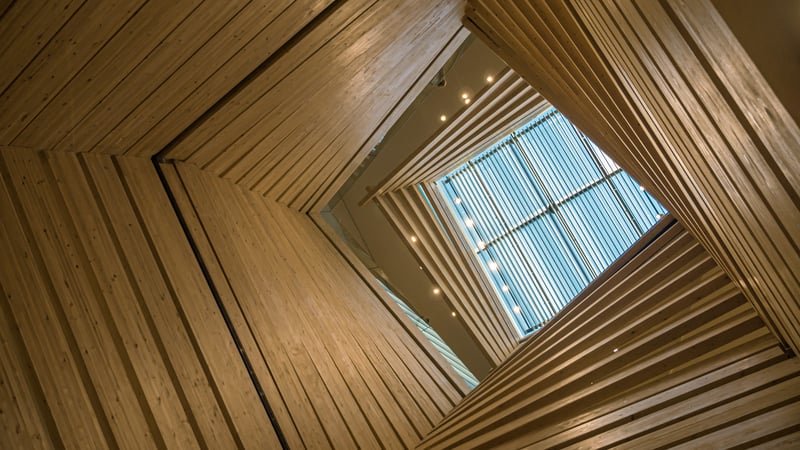
The built environment is a major contributor to the climate crisis, accounting for approximately 40% of the world energy-related CO2 emissions, according to figures from the Global Alliance for Buildings and Construction. Adding to that, demographic growth and urbanization trends are expected to compound the problem, with the sheer number of buildings likely to double between now and 2050. But not all buildings are equal in terms of climate impact. The bulk of the world’s buildings are made of steel and concrete, and the dependency on these two materials comes with a big environmental price tag. Illustrating the scale of the problem, a couple of years ago an article from the Guardian called concrete “the most destructive material on Earth”, emphasizing that if the cement industry was a country, “it would be the third largest carbon dioxide emitter in the world”.
Thankfully, alternative construction methods are gaining increased traction and support. Among them, wooden buildings, and more specifically engineered timber constructions, are offering multifaceted advantages.
From carbon sources to carbon sinks
For one, and this is probably their biggest selling point in view of the ongoing climate emergency, wooden buildings act as carbon sinks by durably storing carbon from the atmosphere. Indeed, when trees are left to rot or end up burning in forest fires, the carbon they have absorbed is released back into the atmosphere. The older the tree, the less carbon it will soak up. In contrast, trees felled to be used in construction buildings continue to store carbon for potentially very long periods of time and the trees that are replanted to compensate for their loss absorb more carbon as they grow.
According to publicly available data, buildings made up of cross laminated timber store 550-650 kg of CO2 equivalent per m3 while the same buildings made up of steel or cement would actually release 400-600 kg of CO2 equivalent. This is not only due to their energy-intensive production process, but also to the fact that concrete building elements also require a lot of energy input for transport and for drying onsite. Additionally, more than half of the emissions generated by cement production actually come from the calcination process.
To sum-up, timber constructions contribute not only to increased carbon storage but also reduced embodied carbon.
Using a noble, nature-based and circular material like wood to solve such a big climate conundrum appears as a dream solution. However, a lot of important safeguards need to be taken first.
Sustainable forest management
When trees are cut down, CO2 emissions will increase for a period spanning from 10 to 30 years until new vegetation takes over, as a lot of carbon is actually stored in the soil and root system. Legal safeguards therefore need to be in place to ensure biodiversity preservation by regulating what needs to be done in case trees are felled and specifying periods of the year when they cannot be disturbed. By selectively extracting timber while paying attention to the remaining vegetation that is left to grow, foresters can even optimize certain functions of the forests like their adaptive capacity.
Scandinavian forests are a good example of such sustainable forestry practices. For each tree that is felled, two new trees are planted, which absorb more CO2 as they are growing. In Sweden, this has contributed to forest resources doubling in less than 100 years.
A scientific study co-authored by researchers from the Postdam Climate Institute in Germany found that sustainable forest management and governance is key to upscaling wood constructions. “Trees offer us a technology of unparalleled perfection”, said Hans Joachim Schellnhuber, one of the study’s lead authors, adding that “societies have made good use of wood for buildings for many centuries, yet now the challenge of climate stabilization calls for a very serious upscaling”.
According to another academic peace co-authored by the same researcher, if 90% of the new urban population were to live in newly constructed timber buildings, approximately 10% of the global carbon budget could be saved.
Carbon credits and the risk of non-additionality
Given all the positive climate credentials exposed above, engineered timber construction projects are increasingly considered for inclusion in voluntary carbon offsetting programmes. Critics however have raised concerns about the risk of non-additionality, arguing it is difficult to prove whether such projects are effectively contributing to increased carbon removals. Robust methodologies, including the one developed by the Puro.earth marketplace, have however been designed to address this challenge by demonstrating and monitoring the effective sustainability and additionality of these projects.
Eligibility to become a CO2 removal credit supplier requires delivering a large series of guarantees including on the sustainability of the raw material used, the production process quality, the assurance that the end life of the product will not cause CO2 release back into the atmosphere and the proof of no double counting. In addition, a buffer for uncertainty is even calculated to account for possible re-emissions during the lifetime of the product. The CO2 removal certificates are only issued after a proper audit has taken place scrutinizing the methodology of the production facility in terms of production process, raw material used and transport.
Since January 2023, all carbon removal certificates issued by Puro.earth require 100 years of minimum durability of the stored carbon. This 100-year minimum threshold is aligned with the time horizon the IPCC uses for inventory and reporting purposes when assessing global warming potential.
According to a recent publication from the green standards NGO ECOS, the current approach to timber buildings lacks a focus on circularity, indicating the need for a change in practices to improve their longevity, modularity, and deconstruction processes. ECOS advocates for a "cascading principle" whereby harvested wood is stored for as long as possible to delay carbon losses, and timber building materials undergo multiple re-use and recycling loops in line with circular economy principles. This underscores the importance of robust carbon credit methodologies for certifying mass timber projects. Organizations like South Pole and the Swiss Timber Finance initiative are actively driving the adoption of such a methodology and are currently seeking official approval from Verra's Verified Carbon Standard, the leading global greenhouse gas crediting programme. A 2023 paper co-authored by the International Society of Wood Science and Technology argues that the financial reward provided by carbon crediting programmes would go a long way to help overcome resistance towards this relatively new building method and compensate its higher costs. Carbon credits for mass timber projects, it adds, have the potential to provide ‘additional, durable and non-leaky carbon benefits’ provided that policy makers address remaining market uncertainties.

Market barriers
At the moment however, the market conditions are not favourable for timber buildings to reach substantial scale. In 2022, an audit from the Council on Tall Buildings and Urban Habitat found that there were only 66 tall mass timber buildings – meaning of more than eight stories – in the whole world (60 of which in Europe), while another 73 were planned or in construction. Indeed, architects and engineers mandated by project developers almost inevitably chose business-as-usual constructions materials (ie, concrete and steel) unless the client made a specific request for timber elements. Emphasizing the point made above, this dysfunctional dynamic could be addressed through carbon financing by providing a genuine incentive to project developers to choose timber elements at the early phase of a project. The fact that they would otherwise most likely have chosen concrete or steel (without the upfront financial incentive) also adds to the argument that carbon financing of such projects brings genuine additionality.
Future perspectives
Large constructions including commercial buildings, office spaces and appartement blocks with long life-time present enormous untapped opportunities to solve the climate challenge. In addition to the multi-faceted advantages we present, engineered timber buildings also present the co-benefits of better air quality, reduced weight, fire resistance, , construction speed and improved insulation. And to add to that list, research also found that they can reduce the stress levels of students in school.
This is maybe what inspired France to adopt a law requiring that 50% of all new public buildings should be made of engineered timber or similar sustainable materials. Using timber in half of new expected urban constructions could actually provide as much as 9% of the 2030 worldwide emission reduction efforts needed to stay within the Paris trajectory.
Last year, the Australian government launched a $300 million Timber Building Programme to encourage sustainable construction as part of its transition to a net zero economy. A report published one year earlier by the Australian Clean Energy Finance Corporation actually found that the embodied carbon of engineered timber buildings could be up to 75% lower than conventional concrete-steel counterparts.
In Texas, which grows about 20% more wood than it harvests, 84 mass timber projects are in design and another 50 under construction or already built. This new impetus for timber construction even led the Bloomberg magazine to launch a dedicated news series called “Timber Town” in its green section, taunting wood buildings as the “next frontier of carbon offsets”.
Let us hope market and policy frameworks will take the hint.